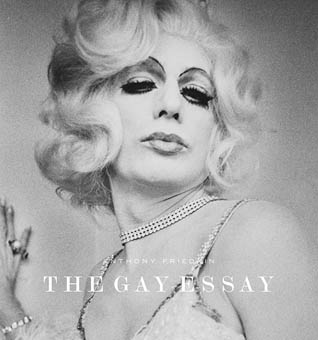ANTHONY FRIEDKIN


This post is also available in:
 Anglais
Anglais
Alors que les lois en faveur du mariage homosexuel sont ou seront bientôt en vigueur dans 17 États des Etats-Unis ainsi que dans une douzaine de pays à travers le monde, le "De Young Museum" de San Francisco présente une fascinante exposition qui revient sur les débuts du mouvement. A travers les photographies de l’Américain Anthony Friedkin, c’est un état d’esprit, des luttes et toute une période qui resurgissent. The Gay Essay, titre de la série, est une documentation humaniste des communautés gay de Los Angeles et San Francisco, réalisée par le photographe californien entre 1969 et 1973, à l’âge de 19 ans.Au printemps 1969, le mouvement moderne des droits des homosexuels se dessine aux États-Unis. Lorsqu’il s’intéresse à cette communauté et à ce moment crucial de l’histoire américaine, Anthony Friedkin est d’abord poussé par le désir de raconter de simples histoires intimes, avant de se joindre au mouvement de façon plus personnelle. A Los Angeles, il passe du temps au Gay Community Services Center, où il rencontre Morris Kight et Don Kilhefner, les fondateurs du Front de libération des gays, qui l’initient à la scène homosexuelle de la ville. Plus tard, il couvrira les manifestations, se rendra dans un théâtre expérimental de San Francisco où se produisent notamment des drag-queens, et publiera ses photographies dans des journaux ou aux côtés d’essais engagés dans la reconnaissance des droits.Les images sont magnifiques. Entre portraits joyeux ou bouleversants, scènes de rue ou moments captés en intérieur, elles illustrent les différentes facettes du quotidien des gays d’alors : salles de danse et clubs où les jeunes homosexuels se réunissent, scène artistique, monde de la prostitution à Hollywood. Anthony Friedkin photographie également à cette époque d’importantes figures de la communauté gay, dont Morris Kight et Don Kilhefner évidemment, mais aussi le révérend Troy Perry, qui accueillait les gays, femmes ou hommes, à la Metropolitan Community Church. En suivant son instinct et peut-être son insouciance, le photographe sort inévitablement de l’analyse distante qu’ont pu avoir certains de ses pairs. C’est l’un des aspects particulier de ce projet qui allie à la fois documentation historique, spécificité et approche personnelle, tant les images sont teintées d’intimité et de rapports confidentiels avec le sujet.Fils d’une danseuse de Broadway et d’un scénariste d’Hollywood, Anthony Friedkin a grandi dans un foyer entouré d’artistes. Ainsi, la plupart des gens qu’il photographie étant jeune sont des proches ou des personnes de son âge, d’où cette relation à la proximité qu’il a entretenue durant toute sa carrière. Peu avant The Gay Essay, il travaille comme pigiste correspondant pour l’agence Magnum. Après ce travail majeur, il tournera son objectif vers les prisons, les prostituées, et explorera en images sa fascination pour la mer et le surf, tout en continuant à documenter activement le quotidien de sa ville, Los Angeles.Coïncidant avec le 45ème anniversaire des émeutes de Stonewall à New York, publié sous forme de livre en juillet dernier chez Yale University Press et Daylight, The Gay Essay ressemble à album de famille conçu avec des images généreuses, si ce n’est que, marqué par l’histoire, il fait aujourd’hui figure de véritable document. THE GAY ESSAY Gay marriage will soon be legal in a total of seventeen American states and a dozen countries across the world, and the Young Museum in San Francisco is holding a fascinating exhibition that looks back at the beginnings of the movement. Through photographs by American photographer Anthony Friedkin, a whole state of mind, a whole period of struggles and history comes to the surface. The Gay Essay is a humanist document of the gay communities of Los Angeles and San Francisco, shot by the Californian photographer, then only 19 years old, between 1969 and 1973.In the spring of 1969, the modern gay rights movement began in the United States. When Friedkin first took an interest in the gay community, he wanted to tell simple, intimate stories, before becoming involved in the movement in a more personal way. In Los Angeles, he spent time at the Gay Community Services Center, where he met Morris Kight and Don Kilhefner, founders of the Gay Liberation Front, who introduced Friedkin to the city’s gay scene. Later, he covered protests, as well as an experimental theatre in San Francisco which specialized in drag shows. His photographs appeared in newspapers next to essays in support of gay rights.The images are beautiful, illustrating the different facets of everyday gay life with portraits, street scenes and interior shots exploring dance clubs, the art scene and the world of prostitution in Hollywood. Friedkin also photographed important members of the gay community, like the reverend Troy Perry, who welcomed homosexuals and lesbians into his Metropolitan Community Church. By following his own instinct, and perhaps his own recklessness, Friedkin escaped the distant, analytical approach from which the work of his peers sometimes suffered. One of the peculiar aspects of this project, which combines historical documentation, specificity and a personal approach, is the intimacy Friedkin shares with the subject.The son of a Broadway dancer and a Hollywood screenwriter, Anthony Friedkin grew up in a home surrounded by artists. As a result, most of the people he photographed were young or close to his age, hence his insistence upon proximity throughout his career. Shortly before The Gay Essay, he worked freelance for Magnum. Following this major work, he turned his focus to prisons and prostitutes, exploring through photographs his fascination for the sea and surfing, all while continuing to documenting the daily life of his city, Los Angeles.Coinciding with the 45th anniversary of the Stonewall Riots in New York, which was published in book form last July by Yale University Press and Daylight, The Gay Essay is like a family album that has become an important historical document.
NEWSLETTER
Pour recevoir nos informations, inscrivez votre adresse email.EN SAVOIR PLUS

Pour Que l’Esprit Vive,
Association loi 1901 reconnue d’utilité publique
Siège social
20 rue Lalande,
75014 Paris – France

